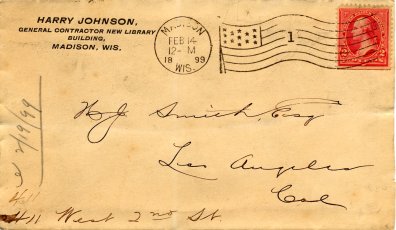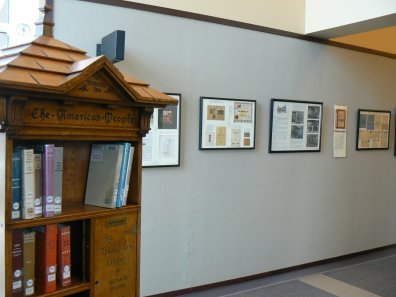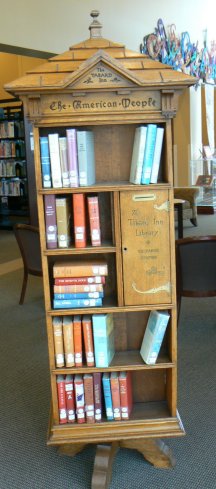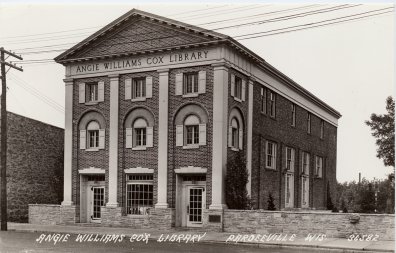 On February 16 the Wisconsin Library Association will hold its annual Library Legislative Day. For a little historical inspiration for this event, there is nothing as appropriate as the story of Margie Sornson Malmberg and the legislative battle for a bill to provide state aid for a bookmobile demonstration project during the 1949 Wisconsin legislative session. This story is well told in Benton H. Wilcox’s The Wisconsin Library Association 1891-1966 (WLA, 1966). Malmberg who was director of the Appleton Public Library from 1946 to 1949 took a leave of absence from her Appleton job to serve as WLA’s executive secretary and legislative representative at the meager salary of $150 per month. According to Wilcox, “… Mrs. Malmberg, without any previous experience, almost by her own efforts … secured passage of the bill through both houses of the legislature … .” The bill, however, was vetoed by the Governor. Wilcox continues, “No one gave even an outside chance to the veto being overridden. But Mrs. Malmberg would not give up. She worked tirelessly, buttonholing assemblymen and senators. … When the legislature reconvened in September the day of decision came, the veto was overridden, and the Demonstration Bill became law. That, in the minds of many, was the Wisconsin Library Association’s finest hour.” The significance of this event was that it was the first time the State had appropriated direct support for community public library service. The result of the legislation was the Door-Kewaunee Bookmobile Project which has been well documented by Christine Pawley. Prior to her service in Appleton, Malmberg (then Margie Sornson) served as librarian of the Chippewa Falls Public Library and the Viroqua Public Library. After her service to the Wisconsin Library Association she and her husband moved to Big Island, Virginia. In 1950, probably because of her legislative experience in Wisconsin, she was appointed Director of the Washington Office of the American Library Association. The Malmbergs moved to Toledo, Ohio in 1960 where Margie went to work for the Public Library of Toledo and Lucas County. She retired there in 1976. The picture of Margie Malmberg above is from the Toledo library’s Images in Time digital collection (Object ID: 22342). Take some inspiration from Margie and attend WLA Library Legislative Day. It’s not too late.
On February 16 the Wisconsin Library Association will hold its annual Library Legislative Day. For a little historical inspiration for this event, there is nothing as appropriate as the story of Margie Sornson Malmberg and the legislative battle for a bill to provide state aid for a bookmobile demonstration project during the 1949 Wisconsin legislative session. This story is well told in Benton H. Wilcox’s The Wisconsin Library Association 1891-1966 (WLA, 1966). Malmberg who was director of the Appleton Public Library from 1946 to 1949 took a leave of absence from her Appleton job to serve as WLA’s executive secretary and legislative representative at the meager salary of $150 per month. According to Wilcox, “… Mrs. Malmberg, without any previous experience, almost by her own efforts … secured passage of the bill through both houses of the legislature … .” The bill, however, was vetoed by the Governor. Wilcox continues, “No one gave even an outside chance to the veto being overridden. But Mrs. Malmberg would not give up. She worked tirelessly, buttonholing assemblymen and senators. … When the legislature reconvened in September the day of decision came, the veto was overridden, and the Demonstration Bill became law. That, in the minds of many, was the Wisconsin Library Association’s finest hour.” The significance of this event was that it was the first time the State had appropriated direct support for community public library service. The result of the legislation was the Door-Kewaunee Bookmobile Project which has been well documented by Christine Pawley. Prior to her service in Appleton, Malmberg (then Margie Sornson) served as librarian of the Chippewa Falls Public Library and the Viroqua Public Library. After her service to the Wisconsin Library Association she and her husband moved to Big Island, Virginia. In 1950, probably because of her legislative experience in Wisconsin, she was appointed Director of the Washington Office of the American Library Association. The Malmbergs moved to Toledo, Ohio in 1960 where Margie went to work for the Public Library of Toledo and Lucas County. She retired there in 1976. The picture of Margie Malmberg above is from the Toledo library’s Images in Time digital collection (Object ID: 22342). Take some inspiration from Margie and attend WLA Library Legislative Day. It’s not too late.








 In 2010 the
In 2010 the 
 November 25, 2010 will be the 175th anniversary of the birth of Andrew Carnegie. This is a great year to celebrate Carnegie’s legacy to the sixty Wisconsin communities and two academic institutions that benefited from library building grants from Carnegie. If a Carnegie building is part of your library’s heritage, why not highlight that legacy during this year. How about a Carnegie birthday during the week of November 25 (Thanksgiving Day) or on some other date that is significant to your library’s Carnegie experience. Take advantage of National Library Week to highlight Carnegie’s legacy. Find out about the story of how your community got its Carnegie grant and the subsequent history of the building and try to get an article about the building in your local media. Locate artifacts and photographs that can be used to help tell your Carnegie story. This can be done even if the Carnegie building in your community has been razed. Put your Carnegie story on your blog and/or website. Create an exhibit in the library using artifacts, archives, and photographs. See if you can find souvenir items such as postcards and china items for your exhibit. Postcards are relatively easy to come by on eBay. You may also be able to purchase images of your Carnegie building from the Wisconsin Historical Society. Arrange with your local post office to have a
November 25, 2010 will be the 175th anniversary of the birth of Andrew Carnegie. This is a great year to celebrate Carnegie’s legacy to the sixty Wisconsin communities and two academic institutions that benefited from library building grants from Carnegie. If a Carnegie building is part of your library’s heritage, why not highlight that legacy during this year. How about a Carnegie birthday during the week of November 25 (Thanksgiving Day) or on some other date that is significant to your library’s Carnegie experience. Take advantage of National Library Week to highlight Carnegie’s legacy. Find out about the story of how your community got its Carnegie grant and the subsequent history of the building and try to get an article about the building in your local media. Locate artifacts and photographs that can be used to help tell your Carnegie story. This can be done even if the Carnegie building in your community has been razed. Put your Carnegie story on your blog and/or website. Create an exhibit in the library using artifacts, archives, and photographs. See if you can find souvenir items such as postcards and china items for your exhibit. Postcards are relatively easy to come by on eBay. You may also be able to purchase images of your Carnegie building from the Wisconsin Historical Society. Arrange with your local post office to have a  On February 11, 1891 (119 years ago today) a group of librarians and educational leaders gathered in the office of the State Superintendent of Public Instruction for the purpose of organizing the Wisconsin Library Association. At that time the State Superintendent’s office was located in the State Capitol. Among those in attendance were
On February 11, 1891 (119 years ago today) a group of librarians and educational leaders gathered in the office of the State Superintendent of Public Instruction for the purpose of organizing the Wisconsin Library Association. At that time the State Superintendent’s office was located in the State Capitol. Among those in attendance were  On February 16 the Wisconsin Library Association will hold its annual
On February 16 the Wisconsin Library Association will hold its annual